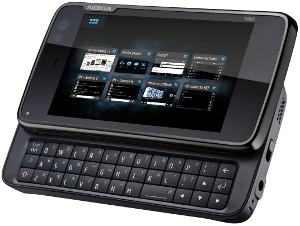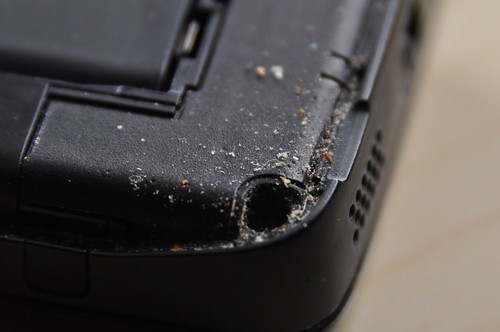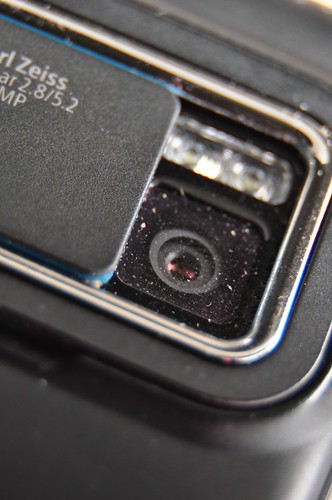
The Nokia N900 is a strange beast, hovering somewhere between phone, tablet and netbook. It’s hard to quantify but I’ve come to rely on it. That is not to say it doesn’t have its faults. Far from it.
What follows is a fairly exhausting but far-from-exhaustive overview of the N900, why I like it but also why I loathe it and the company behind it.
The hardware
Let’s start with what we can see. At first glance, the N900 is a chunky little brick. It’s not as sleek as the iPhone 4 or the unconscionable thin Samsung Galaxy S but its heft makes you think you’ll be able to trust it to keep working for a long time --I honestly thought I’d snap the Galaxy S when I started playing with it.
The screen, while resistive (and therefore not supporting multi-touch), is pretty good. It’s quite bright and responds to light touches really quickly. The stylus is completely optional but allows for a much more accurate experience than you get on a capacitive screen without a stylus. It’s a great representation of its-generation of screen but it can’t compete with the iPhone 4 or Galaxy S.
The keyboard is a keyboard. Just being there is a giant positive for me. The key arrangement is a little strange and part of me thinks there could have been an extra row by extending the screen out a little further but it works well once you acclimatise. I have written entire Python scripts on it. Painful but true.

Before I move off the tangibles, I need to mention the case and its morbid fascination in consuming crumbs, as the photo on the right demonstrates. Believe it or not, it manages to collect this level of detritus within a couple of weeks and my pockets are usually quite clean.
The processor is fairly fast for its generation of smartphones but it won’t keep pace with the next generation. That said, it does everything you ask of it and for people who need more, there is a kernel to overclock it from 600MHz up to 900MHz which I’m going to have to try at some point!
The storage is a double-edged sword. There’s a pretty epic 32GB available on the device but it’s split over various partitions (which mirror different storage hardware inside the phone). There’s 256MB of NAND flash for quick access but the core OS uses this. Then there’s a much slower 32GB eMMC. This is split into three: 2gigs for applications, 768megs for swap and the rest (some 27gigs) is mounted as VFAT under the user’s homedir. The eMMC is slow but NAND is expensive so you can see Nokia’s thought process but the partitioning is not elegantly done and (in my experience) the VFAT partition can crash under heavy IO and require rebooting.
The battery was a concern. It uses the popular BL-5J model battery. In other devices this can give 2-3 days of use but you’ll get 6 or 7 hours of constant full use, which averages out to about a day of good usage. You’ll need to charge this every day. Initially I thought I’d never remember but thanks to its MicroUSB port, I end up charging it whenever I’m at my PC. The USB also doubles up as a method for sharing files and even tethering the phone as a modem. Thumbs up.
That said, I do feel there was a missed opportunity with the USB port. Some muppet decided that they would block USB Host-Mode that the older N8xx devices supported. This would have allowed you to use a gender-bender to plug in any USB device (think: card reader, camera or printer). As somebody who does shoot a lot of photos while out and about, I would have really appreciated this feature.

The main camera is not great but isn’t terrible. It’s on-par with the rest of the camera-phones out there. Nokia needs to do something about this. Just buying in more glass from Carl Zeiss isn’t going to appease the users and frankly, it’s quite damaging to the Carl Zeiss optics brand. It needs a better, larger sensor and, ideally, moving optics. This applies to all current-gen phones (N8, Galaxy S, iPhone 4, etc). They take high resolution shots but the quality can’t touch even the cheapest compact camera.
And as you’ve probably noticed from the image, the main camera with its cover it again a bit of a crud-magnet.
The secondary camera is useless in that it cannot be used at all. This is mostly a failing of Nokia and their inability to keep developing a device once it has left the barn but more on that later.
There are some smaller features worth mentioning that don’t warrant a paragraph: FM transmitter (so you can listen to sound on nearby radios), a nice physical lock switch on the bottom, lens cover on the main camera, stereo speakers and a flimsy kickstand to hold it at a angle on a desk.
All in all, the hardware is one of the better aspects to this phone. It won’t compete against newer phones but it’s a solid representation for a 10-month old phone.
The built-in software
Let’s start with the desktop. You’re given a 4-pane scrolling display to customise. You can place application launchers, links to bookmarks, links to contacts and “widgets” (apps that just run on the desktop). You switch desktops by dragging. Standard stuff. Whether you want this or not is up to you. I only use one desktop and you can lock it to one quite easily.
You use the menu for everything else and since they upgraded the software to PR1.2, the menu contains everything in a user-sortable grid. Using the menu is faster than scrolling desktops. The initial software’s menu was rubbish. I’m thankful Nokia noticed this and did something about it.
The browser works. It’s leaps and bounds better than my old N95’s but still a long way behind a desktop browser. It renders pages quite fast but it’s not very good when you have multiple tabs open. Switching between browser windows forces a refresh and that incurs a few-second wait. There are also some missing fonts (where is Georgia?!), but it’s not an unpleasant experience. It has Flash and this mostly works quite well if a little slowly.
I still hate Flash but it’s nice to have the option to use it.
The contacts library is a little scary. All your contacts from all your service accounts are merged into one giant list and once you start adding in Skype, MSN, Facebook Chat, etc contact lists, you’re left with a pretty monstrous list where you tend to have separate contact entries for the same person on each service. You can manually merge them all into one set of names (so there are no duplicates) and select the service from the detail screen but it can be an arse-load of effort to go through and merge everything. (There are user-contrib apps to help with this)
One nice thing is you can search your contacts by typing on the home desktop. It’ll just start searching without any effort. As a result, I never go into the contacts list directly.
The main game-changer for me has been email. On my N95 I would never have considered the email client as capable – it wasn’t – but now my N900 checks for new mail every 5 minutes over IMAP to GMail but there is limited support for MS Exchange and with PUSH support. However there has been a bug in the email client that consumes all your CPU for five minutes if you try and download images for an email. This is a pathetic bug that Nokia should have fixed 10 months ago.
Messaging follows the --now common-- conversation-based metaphor where messages to one person are rolling. This is great. Nokia integrated a set of instant-messaging clients into the same interface to make chatting with people on Skype (and since release MSN, Yahoo, Facebook, etc). They could have integrated MMS but didn’t. MMS isn’t supported at all out-the-box, you need fMMS. They could have integrated email into the same interface, but didn’t. They missed opportunities to revolutionise the way people interact.
Notifications from incoming email, SMS and IM are pretty good. You get a small gold pop-up that you can click on if you’re using the phone or a large gold box in your application switcher if you’re not using the phone at the time.
Customisation tools could have gone further. Much older Nokia phones have provided advanced profile features for allowing you to have time-set profiles (eg, no buzzing from emails after midnight!) but this doesn’t appear to be part of the default remit.
Overall the default package feels like a proof of concept that somehow got itself on the production line. It has sharp corners in places and the lack of some very basic features will leave some people frustrated and begging on forums for people to write an application for something that should have been handled out-the-box.
Third party applications
“Apps” seem to define the long-term lifespan of modern smartphones. The iPhone broke this news and few would argue that despite all the odds, Apple has made it work.
The N900, being a true Linux-running phone, has a repository of software, accessible through Application Manager. App Manager is just a frontend to an APT database (the package distribution tool used in Debian and Ubuntu). It gives you access to hundreds of free, some open-source applications but given APT’s design, there’s no paid software available through this interface but there are a lot of ports from desktop Linux.
My favourite game ports: Battle For Wesnoth, Hex-a-hop, Gweled, Beneath a Steel Sky, Quake 3/OpenArena, OpenTTD, PokerTH, The Ur-Quan Masters, Heroes of Might and Magic 2, and so many awesome emulators: Gameboy, Master System, PSX, Mega Drive, NES, SNES, MAME, C64, ZX Spectrum, Atari ST.
One big negative with APT is it doesn’t sit very well on a low-powered device when you have large repositories (like extras-devel – where all the cool stuff is). I love APT but it grinds to a halt every time you load it, install something or remove something… And thanks to Nokia’s insistence that they reinvent the wheel, you can only do one thing at a time. If you want to remove three applications, you have to remove one, wait for five minutes, remove the second, wait again and then remove the third. It’s nowhere near good.
You need the Ovi Store for paid things. The Ovi Store is Nokia’s answer to the Android Market and iPhone App Store. But there’s a problem: it’s complete and utter shit. I had wanted to get through this review without swearing but there’s no other way of putting it. Nokia screwed up. There’s barely any commercial software in the Ovi Store and I doubt there’s much worth buying on its way. The only thing I have bought is Angry Birds and Nokia even managed to screw that up by giving the first extra-level pack away for free.
It’s also one of the worst-integrated stores I’ve ever seen. Like the Android Market, it’s web-based but it won’t remember who you are and it forces you to log in for free things. When you do manage to download something, it kicks off the download in the proper Application Manager and (as mentioned above) that takes a good long time to get going.
Even with the two slow and/or awful package managers, there is some quality software to be had from the Maemo development community, who, I have to say, have done infinitely more work on this phone than Nokia themselves have. Without them, the N900 would be barely usable.
Nokia
Nokia is a huge company. They have fingers in thousands of pies. They employ ~123,000 people in 120 countries and over a quarter of these people are employed in Research and Development. They design phones, create the software (currently the old Nokia OS, Symbain, Maemo and now Meego), develop projects like Qt, get involved in wireless networking. They have also acquired dozens of companies that do various things that they have or plan to integrate into their service-level library including solutions for buying music, messaging, contact syncing, mapping, backup and until recently file-sharing (Ovi Files).
Being such a large entity, with so many fingers in so many pies, you can see how a device like the N900 could slip out in a relatively unfinished state. They don’t seem to have the focus as a company to say “This is the operating system we’re going to develop, we’re only using this for the next 10 years and we’ll put everything into it”. Instead they seem to want to keep spawning new projects and porting features to it if and when they feel the need.
In this vein, Maemo (the operating system on the N900) was supposed to represent the future of Nokia smartphones. Instead Nokia had a spasm and decided to merge with Intel’s Moblin, effectively killing off Maemo (and all the community-contributed work) in the process. Maemo will live on but without development from Nokia.
Then there’s the developer support for the N900. The Ovi Store came months after its release and even then they bodged it up because they hadn’t engaged more than one company (Rovio) to write any games. There were a few tech demos where you can ooo and aaa at the graphics but little else. To every other developer this sent the clear message: DON’T DEVELOP APPS FOR THIS PHONE!
I’d like to get excited about Meego but I need to see how committed Nokia are to the platform. I’m definitely not going to buy one until I have seen some commercial applications come out for it. That’ll be a sign for me that they’re doing something right.
But through the N900, Nokia have displayed that they are stretched too thin. They haven’t maintained the N900’s core software for a proper life-cycle, they haven’t been on top of their (frankly, lamentable) “services” and as a company they seem to be shedding VPs like fleas.
They have a lot to do before I’ll trust them enough to buy another Nokia phone.
Conclusion
The N900 was an exciting phone when I bought it. It allowed me to embrace my inner geek and shake him until he passed out. It can do a lot through its Linux backend but getting into that frame of mind requires knowledge of what you’re doing.
Mainstream consumers who want a full feature-set and a large repository of quality applications, some commercial, wont be fulfilled by the N900 as it delivers neither. It’s about as far away from a consumer device as you can get without talking about electronics.
Linux enthusiasts and developers who want something that is fun to hack away on but gets attention where it’s needed, also probably wont be content. While it delivers oodles on the first count, Nokia have been awful when it comes to updating the software, making for a very rough experience in some areas.
The one saving grace is ironically what killed Maemo: Meego. It looks like it’ll be able to run on the N900 with community support but I suspect I’ll be bored of the now-under-fuelled RAM and CPU by that point that becomes viable.
The N900 could easily be my last Nokia device. It depends what they do with Meego. The allure of a mobile operating system (like Android) that is actively maintained and has a healthy application ecosystem is too tempting.